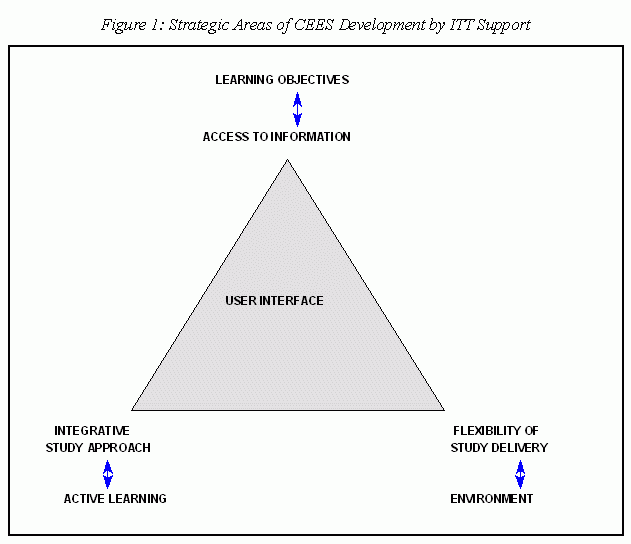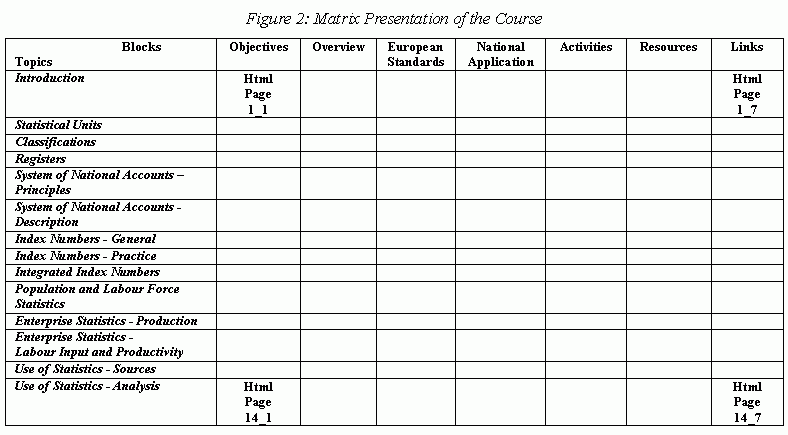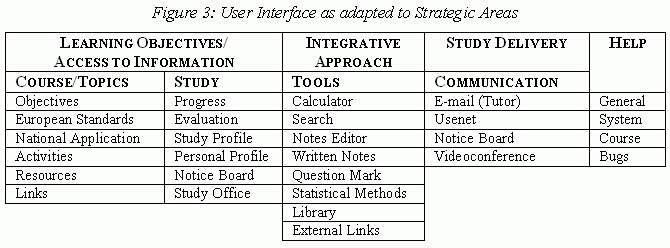Recent fascinating development of information and telecommunications technology has made vast amounts of data available to many millions throughout the world. Official statistics represents important segment of these data. Widespread and increased use of conceptually and methodologically complex official statistics requires appropriate users' training. The central issue of the paper is the question how modern information and communication technology (ICT) could be used to increase quality and efficiency of users' training in the field of official economic statistics. Three strategic areas of ICT application in the course development process are identified: extension and deepening of student's access to information, increased flexibility of study delivery and integration of student's learning experiences and knowledge. The paper outlines the course development methodology designed for effective integration of ICT and contents by the Faculty of Economics/University of Ljubljana. The adaptation of the basic user interface developed by the Faculty of Electrical Engineering/University of Ljubljana to specific course requirements is also described.
Commercial and non-commercial electronic databases on mass storage and distribution media provide large, highly focused data-sets. These are particularly common in the field of business and economics. Business and economic databases usually contain statistical data, which are heterogeneous in terms of their providers, media, accessibility, contents etc.
Among the most important providers of statistical data in the field of business and economics are national and supranational statistical agencies or other institutions, which are authorized by law for collection, production and dissemination of official statistical data (official statistics) according to theoretically founded and officially approved methodologies. These data represent the basis for important part of research and decision making processes in the field of business and economics. As data users should be familiar with methodologies behind the data, these should be given particular attention in specialized credited or non-credited statistical courses on higher education level. Unfortunately, the survey of available courses on business and economic statistics courses shows that the need for appropriate users' training is somehow neglected.
The initiative for the development of a modern course on official statistics had thus risen from the nonexistence of a course on official economic statistics which would meet the needs of the well-defined target groups in terms of its contents, level and flexibility on the one and exploit the tremendous possibilities of the modern information technology on the other hand.
Given the existing teaching experiences and the real need for the economic statistics course modernization (the course is taught at the Faculty of Economics/University of Ljubljana), it was decided to develop a pilot on-line course of European Economic Statistics (acronym CEES) for the post-secondary educational level of 90 study hours (this study load roughly corresponds to the extent of 30 lecturing hours).
The consortium of CEES course development partners includes Faculty of Economics (FE) and Faculty of Electrical Engineering (FEE) from Ljubljana/Slovenia, Faculty of Economics and Business Administration from Sofia/Bulgaria and the Training of European Statisticians Institute from Luxembourg. CEES development was financed by Phare funds in the framework of the Phare Multi-Country Programme in Distance Education - Course Modules Development Project.
The main objective of the CEES was to develop the original course module of economic statistics for non-statisticians at the higher education level, taking into account recent developments of Eurostat statistics. The available ICT should be used to enhance educational possibilities in innovative way from the viewpoint of the course access, contents and level, in order to meet diversified needs of different target groups (e.g. students of business and economics, students of social sciences, government officials, researchers and analysts in both private and public sectors, journalists etc.).
The prevailing idea was that the course on economic statistics by its very nature (focused on the appropriate use of large scattered decentralised databases diversified by various aspects, e.g. by users, contents, type of data, media etc.), could profit substantially from the creative use of ICT. In other words, the use of ICT can increase the quality and efficiency of the course in three strategic areas:
As showed in Figure 1, access to information, flexibility of study delivery and integrative study approach are considered to be crucial strategic areas that help increasing efficiency and quality of study when using modern technology in the field of economic statistics. Their identification is derived from specific course requirements which include:

For effective integration of ICT into the course, FE designed the special course development methodology whereas FEE contributed the software support. FEE's previously developed integrated on - line DE system was adapted to specific CEES course needs. The main strategic characteristics of both course development methodology and adaptation of software support to specific course requirements are outlined in the following sections.
In the information society, studying and solving real-life problems equals using the potentials of hypermedia whose main advantage is non-linearity. In practice this means that the user does not have to follow a course in a set manner (e.g. page 1, page 2 or chapter A, chapter B etc.) as in a traditional learning process. Instead he/she has a freedom to roam around the application, to move from one node to another via semantic links, searching for desired information.
The loose, associative and non-sequential structure of hypermedia systems can also be a disadvantage. Hypermedia are not well suited to situations where directed learning is required as it is the case of an undergraduate course on economic statistics, where the sequence of chapters and the hierarchical structure of the course are defined by logical relationships among the studied topics.
Additional danger of hypermedia is a high level of students' temptation to click on links as they appear and go from node to node without any serious attempt to assimilate the information contained in individual nodes and thus not gain the knowledge specified in learning objectives.
In order to keep the advantage of hyper-media non-linear study possibilities and to fulfill the requirements of direct learning imposed by the learning objectives of the CEES, a specific course development approach was developed. It is based on the course contents modularization combining linear and non-linear study paths.
The fundamental hierarchically built structure of a traditional course is split into topics. Each topic contains several blocks. Blocks embody course contents (Overview, European Standards, National Application) or pedagogic support with guidance to additional sources of information (Objectives, Activities, Resources, Links). The breakdown of the course by topics and blocks leads to a matrix presentation of the course, which helps course developers to create nodes and links in a consistent, transparent and meaningful way (see also Figure 2).

Each cell in the matrix represents a basic html unit. If necessary, some cells can be further divided into new html pages or can be left empty. Each html page can contain several types of links: explanations and cases within a html page (in the so-called "pop-up" window); internal links (links to pages within the course) and external links (links to outside web-sites). All these features are supported by the corresponding navigational tools.
Flexibility of study delivery is the distinctive feature of distance learning, which can be fundamentally enhanced by tremendous possibilities of modern information and communications technology. Not only is the study delivery no longer dependent on the teacher's and students' presence on the same geographical location (which is especially important for part-time and distance students). The important fact is that the quality of study delivery can be improved by increased flexibility also in the "traditional" classrooms.
The course flexibility can be achieved through specially prepared study materials (based on experiences from printed DE self-study materials preparation projects) and through professor - tutor - students communications via advanced communications channels (e. g. videoconferencing , e-mail, chat groups etc.).
Active learning is based on the presumption of students' ability to creatively link together information and knowledge from different sources and manage a break-through in order to gain and retain new knowledge. Such an integrative study approach is facilitated by ICT tools. The majority of them are standardized and available in common software packages.
It is planned that CEES students should have access to and knowledge how to use the following common programmes:
The preparation of the CEES course is based on the presumption that students have access to these standard tools - either at home, at work, at the faculty or at the study center.
The basic user interface was developed at the FEE.
Integrated On-line DE System (IODES) functionally consists of two main parts: the User - System Interface (U - SI) and the Tutor - System Interface (T - SI). These interfaces support two functionally completely different elements of educational programme, which are interconnected by the users, educational course and the efficiency of the educational programme.
From the technical point of view, the IODES is based on Internet services. However, standard Internet services (e.g. WWW) do not permit the individualisation of the study environment and differentiation among individual users. Thus, they do not facilitate individual performance monitoring. Therefore, the key task in the system development was the preparation and integration of specific functions, needed in the DE processes, using a special FEE server.
The apt solution proved to be a connection of the server with a relational database. The data model consists of four types of data:
It is important to point out that the graphical appearance of the user's and tutor's interfaces is mostly independent from their functionality.
Although, from the technical point of view, the IODES was acceptable for CEES, it did not fully correspond to specific course requirements as defined by the strategic areas of ICT implementation. In order to meet these needs, the system was adapted in two main areas. Adaptations were either related to the graphical users' interface or to the system functionality.
At the upper end, the CEES user interface has a toolbar which includes navigation and system function call buttons. The latter are organised in five groups: Topics, Study, Tools, Communication and Help (see also Figure 3). The first four groups are related to CEES strategic areas: access to information, integrative study approach and flexibility of study delivery.

In addition, some new system functions were developed for CEES. The most important are the following:
New functions were specified and possibilities for their implementation were created within the scope of the system architecture. The system's adaptations were implemented and tested. They might be further improved in the future.
The pilot delivery of the CEES course was carried out in February and March 1999 at the University of Ljubljana's Faculty of Economics and at the Faculty for Economics and Business Administration of St. Kliment Ohridski University in Sofia. If the evaluation results permit, the course will be integrated into regular study programmes at both faculties and offered to different target groups outside the academic sphere.
In this paper we presented our view of an on-line course development process. Its salient point (assumption) is the awareness of the changing roles of teachers and students (teachers are not only providers and students are not only passive recipients of information).
Obviously, compared to traditional educational programmes, an on-line course is much more complex and demanding in terms of its development procedures. An appropriately designed on-line course enhances the complexity of an educational product because it integrates various educational services (e.g. self-developed study materials combined with outside on-line sources, administrative and study support services etc.) into one integral product mix. Thus, it brings more flexibility into the learning process in terms of contents, time, pace and place of study. The integration of various educational functions into one product makes the quality aspects of educational process more transparent and open.
Knowledge, co-operation and team work of course developers (teachers), information technology experts, web pages designers, translators, official statistics providers, administrators in study centers etc. were indispensable for the CEES development.
In the course development process, we learned a great deal about official statistics providers, web sites' information organization and structure and also about our own strengths and weaknesses. Research carried out within the CEES project indicates that the on-line dissemination of official statistics is still in its initial development stage. For thorough future exploitation of the ICT advantages in the field of economic and business statistics, systematic and cooperative research efforts of academics, professional statisticians, information technology experts and users are needed.
Lea Bregar, Irena Ograjenšek
University of Ljubljana
Faculty of Economics
Kardeljeva plošcad 17
1000 Ljubljana
Slovenia
Phone: 00386 61 1892 400
Fax: 00386 61 1892 698
E-mail: lea.bregar@uni-lj.si
irena.ograjensek@uni-lj.si
CEES Project Homepage: http://www.ef.uni-lj.si/projekti/cees/